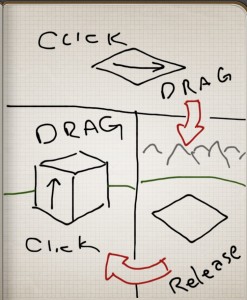 I’m sure other people doodle sensible things. Me, I doodle GUI interfaces. (And then obsess over whether the initial “click-drag” should start from a corner of the shape, or from the middle of the shape)
I’m sure other people doodle sensible things. Me, I doodle GUI interfaces. (And then obsess over whether the initial “click-drag” should start from a corner of the shape, or from the middle of the shape)
Anyhow. I’ve been thinking a lot more about how best to set up MMORPG Tycoon 2’s world building. The more I think about it, the more I’m starting to realise that thinking about “buildings” is probably too large-scale; that really, the player shouldn’t be placing “inns” and “taverns”, but should instead be placing “innkeepers” and “barkeeps”. The buildings themselves are kind of immaterial; the important thing is the NPC who provides a service.
Or to put it another way: There’s nothing special about the auction house in Stormwind, except that that’s where the auctioneers are.
Yes, the buildings do need to be there for graphical reasons.. but maybe there shouldn’t be distinctions between “Inn” and “Tavern” and “Weapon Shop” — there should just be a variety of buildings to pick from, and instead you’d have Innkeepers and Shopkeeper NPCs, and the PCs would seek out those NPCs the same way that they currently seek out particular types of building.
Pro: More like real MMORPGs. Means that different parts of the world can look very different, since we’re not forced to have the same model for an “inn” everywhere. Makes it less damaging to the game to let players build their own buildings in some sort of editor, which would really let players be extra-creative in their world-building.
Con: Makes it much harder to see how services are laid out in a town or city, since the functional pieces would be very small (and probably difficult to distinguish) NPCs, instead of being very large and iconic buildings. Probably means that I’d need to model building interiors, so there’d be somewhere to place the NPCs. After all, it would probably be weird for a shopkeeper to stand around and do business just outside his shop. On the other hand, there are plenty of real MMORPGs where vendors just stand around on plinths; shops aren’t always (or even usually) located inside buildings.

